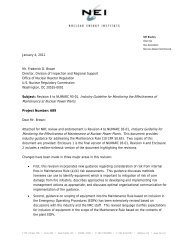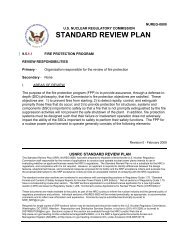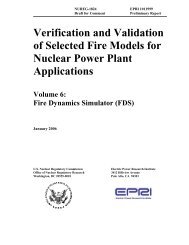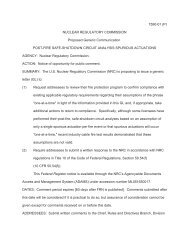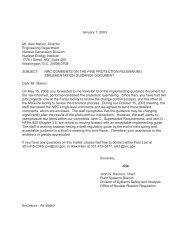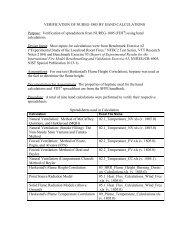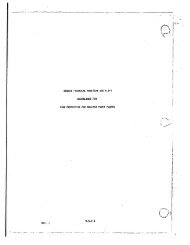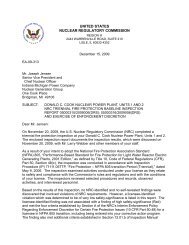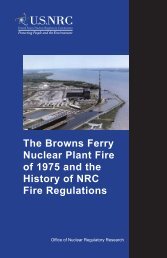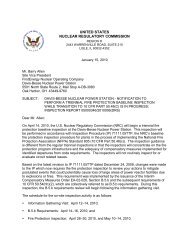NUREG/CR-6850, Volume 1 - NRC
NUREG/CR-6850, Volume 1 - NRC
NUREG/CR-6850, Volume 1 - NRC
Create successful ePaper yourself
Turn your PDF publications into a flip-book with our unique Google optimized e-Paper software.
Overview of the Fire PRA Methodology• Uncertainty and Sensitivity Analyses (Task 15). This task describes the approach to followfor identifying and treating uncertainties throughout the Fire PRA process. The treatmentmay vary from quantitative estimation and propagation of uncertainties where possible(e.g., in fire frequency and non-suppression probability) to identification of sources withoutquantitative estimation, where knowledge of a quantitative treatment of uncertainties isbeyond the state-of-the-art. The treatment may also include one-at-a-time variation ofindividual parameter values to determine the effect on the overall fire risk (sensitivityanalysis).• Fire PRA Documentation (Task 16). This provides suggestions for documenting aFire PRA.The set of analysis procedures provided in <strong>Volume</strong> 2, to a large extent, represent a singleintegrated analysis procedure. Many of the analysis tasks have been built around the foundationsand assumptions of other inter-related tasks. The maintenance of task-to-task consistency is arequirement of any quality Fire PRA. Hence, the user should be very cautious whenever analternative approach is undertaken. In particular, piece-meal modifications to task approaches,assumptions, recommended numerical values, or procedures may introduce inconsistencies oruntreated dependencies. The authors acknowledge that alternative analysis methods do exist, andthat their incorporation into the overall analysis framework presented here may be appropriate.However, implementation of an alternative approach to any given aspect of the analysis shouldinclude explicit consideration of the implications for other tasks. It is the analyst’s responsibilityto ensure that analysis consistency and task independence is maintained, or that anydependencies introduced are appropriately treated.2.3 General Assumptions and Technical PositionsThere are a number of general assumptions that govern this methodology and positions relevantto the application of these methods. These assumptions and positions are summarized in thissection. Note that this section is not intended to provide an exhaustive listing of analysisassumptions. Each task procedure (see <strong>Volume</strong> 2) discusses relevant assumptions. Thediscussion here is intended only to highlight certain key aspects of the method that reflect asubstantive change in analysis approach and/or high-level methodological limitations.2.3.1 Component Selection and Fire-Induced Risk Model2.3.1.1 General Component Selection ProcessThe methodology related to component selection and development of the Fire PRA model forpost-fire SSD response is substantially more explicit than has been typical of past Fire PRAmethodology documents. Past practice has typically given analysts wide latitude to choose whichsystems and functions, and which specific components, to include in the SSD response model.Component selection still involves analyst judgment, but the new approach provides a structuredapproach to this task that is specific to the risk analysis context. The approach is designed toensure that those components whose failure or mal-operation may compromise a credited system2-6





